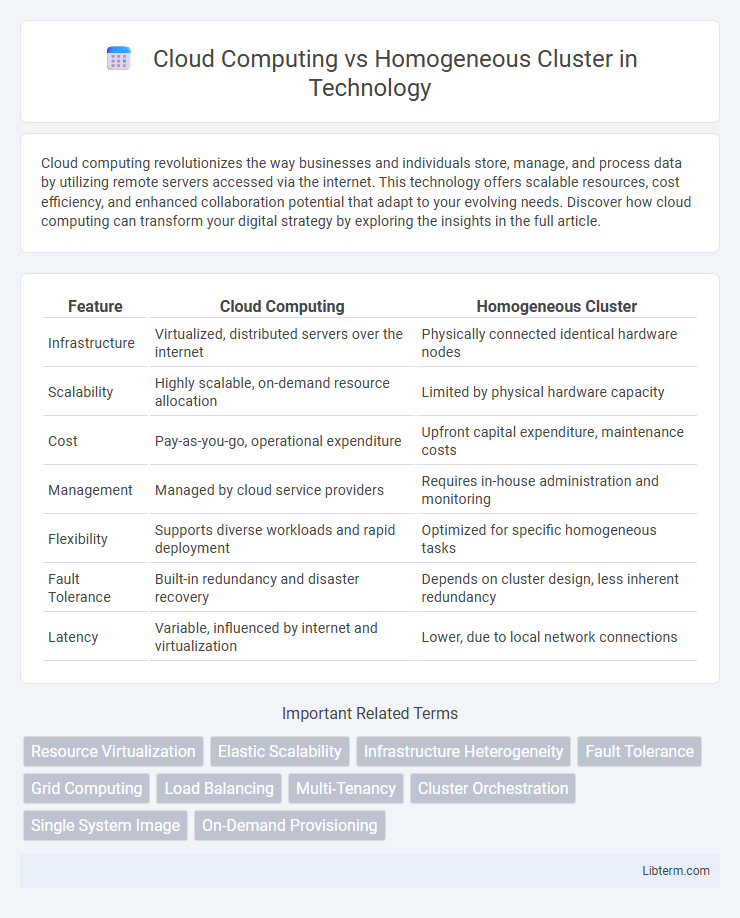Cloud computing revolutionizes the way businesses and individuals store, manage, and process data by utilizing remote servers accessed via the internet. This technology offers scalable resources, cost efficiency, and enhanced collaboration potential that adapt to your evolving needs. Discover how cloud computing can transform your digital strategy by exploring the insights in the full article.
Table of Comparison
| Feature | Cloud Computing | Homogeneous Cluster |
|---|---|---|
| Infrastructure | Virtualized, distributed servers over the internet | Physically connected identical hardware nodes |
| Scalability | Highly scalable, on-demand resource allocation | Limited by physical hardware capacity |
| Cost | Pay-as-you-go, operational expenditure | Upfront capital expenditure, maintenance costs |
| Management | Managed by cloud service providers | Requires in-house administration and monitoring |
| Flexibility | Supports diverse workloads and rapid deployment | Optimized for specific homogeneous tasks |
| Fault Tolerance | Built-in redundancy and disaster recovery | Depends on cluster design, less inherent redundancy |
| Latency | Variable, influenced by internet and virtualization | Lower, due to local network connections |
Introduction to Cloud Computing and Homogeneous Clusters
Cloud computing delivers scalable computing resources over the internet, enabling flexible access to data storage, applications, and processing power without physical hardware constraints. Homogeneous clusters consist of interconnected identical servers working together to enhance computational performance, reliability, and resource utilization for specific workload demands. Understanding the distinctions between on-demand cloud services and dedicated homogeneous clusters informs optimized infrastructure decisions for businesses.
Key Definitions: Cloud Computing vs Homogeneous Cluster
Cloud computing is a technology that delivers on-demand computing resources, such as servers, storage, and applications, over the internet with scalable and flexible infrastructure. A homogeneous cluster refers to a group of interconnected computers with identical hardware and software configurations designed to work together as a single system for parallel processing and high availability. The key difference lies in cloud computing's elastic resource allocation and multi-tenant architecture versus the fixed, uniform, and tightly coupled nature of homogeneous clusters.
Architectural Differences
Cloud computing architecture leverages distributed virtualization, enabling resource pooling across geographically dispersed data centers, whereas homogeneous clusters consist of tightly-coupled, uniform hardware nodes within a localized environment. Cloud systems emphasize multi-tenancy and dynamic scalability through hypervisors and software-defined networking, contrasting with homogeneous clusters optimized for predictable, low-latency inter-node communication via high-speed interconnects. The architectural divergence is further highlighted by cloud platforms' reliance on abstraction layers and APIs for resource orchestration, while homogeneous clusters prioritize direct hardware-level control and resource scheduling.
Performance Comparison
Cloud computing offers scalable resources with variable performance depending on workload distribution and virtualization overhead. Homogeneous clusters typically provide more predictable and consistent performance due to uniform hardware and dedicated network infrastructure, minimizing latency and maximizing throughput. Benchmark tests often show homogeneous clusters outperform cloud environments in high-performance computing tasks because of reduced resource contention and optimized communication protocols.
Scalability and Flexibility
Cloud computing delivers dynamic scalability through on-demand resource allocation, enabling rapid scaling both vertically and horizontally to accommodate fluctuating workloads seamlessly. Homogeneous clusters, composed of identical nodes, offer predictable performance but are limited in flexibility, as scaling often requires manual hardware additions and homogeneous infrastructure maintenance. Cloud platforms provide superior flexibility by supporting diverse instance types and configurations, optimizing resource usage according to specific application needs.
Cost Analysis: Cloud vs Homogeneous Cluster
Cloud computing offers scalable resources with pay-as-you-go pricing, reducing upfront capital expenditure compared to homogeneous clusters that require significant initial investment in hardware. Operational costs for cloud services include ongoing subscription fees and potential network charges, whereas homogeneous clusters incur costs related to maintenance, power consumption, and physical space. Total cost of ownership analysis typically shows cloud solutions as more cost-effective for variable workloads, while homogeneous clusters may be economical for consistent, high-intensity computing needs.
Security and Compliance Considerations
Cloud computing offers dynamic security features such as automated patch management, encryption at rest and in transit, and compliance certifications including ISO 27001, SOC 2, and GDPR adherence, which are managed by cloud service providers. Homogeneous clusters provide greater control over environment security through customized firewall configurations, physical access restrictions, and tailored compliance protocols but require dedicated internal expertise to maintain security standards. Organizations must assess cloud providers' shared responsibility models versus on-premises cluster governance to ensure regulatory compliance and data protection aligned with industry-specific requirements.
Use Cases and Applications
Cloud computing excels in scalable web hosting, big data analytics, and disaster recovery by providing on-demand resource allocation and global accessibility. Homogeneous clusters are ideal for high-performance computing tasks, scientific simulations, and parallel processing workloads requiring uniform hardware for optimized performance. Enterprises often choose cloud platforms for flexible application deployment, while research institutions prefer homogeneous clusters for consistency and predictable compute environments.
Pros and Cons of Each Approach
Cloud computing offers scalable resources, rapid deployment, and pay-as-you-go pricing, facilitating cost efficiency and flexibility for variable workloads, but it may suffer from latency issues and less control over data security. Homogeneous clusters provide consistent performance with optimized hardware configurations and low-latency communication, making them ideal for tightly coupled parallel processing, yet they require significant upfront investment and limited scalability. Choosing between cloud computing and homogeneous clusters depends on workload patterns, budget constraints, and specific performance or security requirements.
Choosing the Right Solution
Selecting between cloud computing and homogeneous clusters depends on workload requirements and scalability needs. Cloud computing offers flexible resource provisioning, cost-efficiency, and easy maintenance for variable or large-scale applications. Homogeneous clusters provide optimized performance and control with uniform hardware, ideal for predictable, high-performance computing tasks requiring low latency.
Cloud Computing Infographic

 libterm.com
libterm.com